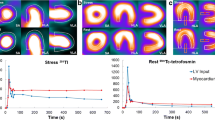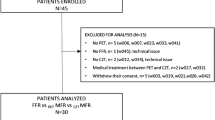Abstract.
In patients without previous myocardial infarction, the single-injection stress perfusion/rest function (SISPRF) approach using stress technetium-99m methoxyisobutylisonitrile (MIBI) gated single-photon emission tomography (SPET) can substitute for conventional stress-rest myocardial perfusion imaging for the assessment of myocardial viability. This study compared pre-operative single-injection, single-acquisition 99mTc-MIBI gated SPET and conventional stress-rest imaging for the prediction of myocardial viability in patients who underwent coronary artery bypass surgery (CABG). Rest thallium-201 SPET followed by stress 99mTc-MIBI gated SPET was performed in 20 patients [nine with previous myocardial infarction (MI) and 11 without previous MI). The study was performed before and 3 months after CABG, and viability assessment was validated by wall motion improvement after CABG. A four-point scoring system (0–3 for normal to absent tracer uptake) for 17 segments of the left ventricular myocardium was used for the assessment of stress and rest uptake. Wall motion, wall thickening and perfusion status were analysed by semi-quantitative visual assessment. On gated SPET, perfusion defect reversibility was considered present when a definite perfusion defect was observed and wall motion or thickening was normal or showed only a mild decrease. In patients with a previous MI, the left ventricular ejection fraction improved significantly after CABG (46%±7% vs 42%±11% before CABG, P<0.05). In patients without previous MI, the ejection fraction improved significantly after CABG (50±12% vs 44%±16% before CABG, P<0.05). In patients with previous MI, positive predictive values using the stress-rest reversibility and SISPRF approaches were 91% and 90%, respectively, and corresponding negative predictive values were 25% and 18%. In patients without previous MI, positive predictive values using the stress-rest and SISPRF approaches were 70% and 61%, respectively, and corresponding negative predictive values were 63% and 14%. It is concluded that SISPRF SPET study is of similar value to conventional stress-rest perfusion study in predicting wall motion improvement in patients with a previous MI, but that it is of limited value in predicting the myocardial viability of patients without previous MI, owing to a lower predictive value.
Similar content being viewed by others
Author information
Authors and Affiliations
Additional information
Received 13 March and in revised form 22 August 2000
Electronic Publication
Rights and permissions
About this article
Cite this article
Yoon, S., Lee, D., Chung, JK. et al. Comparative study of single-injection, single-acquisition 99mTc-MIBI gated SPET and stress-rest perfusion SPET for the evaluation of myocardial viability after bypass surgery in coronary artery disease. Eur J Nucl Med 27, 1747–1753 (2000). https://doi.org/10.1007/s002590000386
Published:
Issue Date:
DOI: https://doi.org/10.1007/s002590000386




